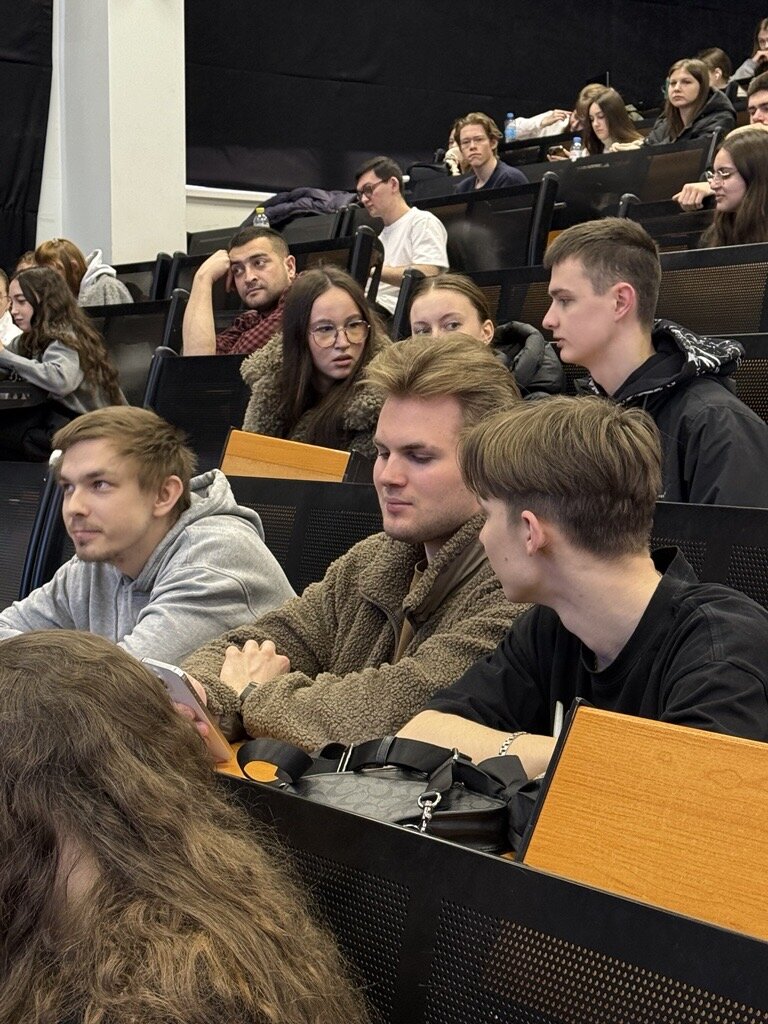 Dmitry Kutovoy with a 3D model of a SMO participant
Dmitry Kutovoy with a 3D model of a SMO participant As part of patriotic education for students, the Faculty of Economics and Management held a seminar "Heroes", during which students listened to a lecture by Dmitry Kutovoy, a specialist in working with youth in the section "Theory and practice of search work" of the teenage and youth club "Unconquered frontier" of the Krasnoselsky District of St Petersburg. He is the founder of the Civic-Patriotic Center "Victory", the commander of the youth search squad "Ligovsky", a deputy of the seventh convocation of the Uritsk municipal district, the winner of the grant project for the preservation of the historical heritage of Russia "That which is impossible to forget" and the project "Through the ages", a competition for the provision of a subsidy from the Committee on Youth Policy, the winner and prize-winner of the regional stage of the Professional Skills Competition. He was awarded the badge of distinction "For contribution to the perpetuation of the memory of those who died defending the Fatherland."
"Our club has been involved in the patriotic direction, including training activities in educational institutions and search work, for ten years now. Over these years, we have seen that many methods of perpetuating memory have become outdated, so we decided to diversify them in order to keep up with the times and achieve greater understanding and interest among the younger generation. To this end, club members have developed digital projects that have been well received by young people," said Dmitry Kutovoy.
"About the war" is one of these projects. It consists in preparation and digitalization of information about exhibits transferred by hunters to patriotic museums of educational institutions. Thus, museums receive labels with a QR code, by clicking on which you can read informative articles about the exhibits.
Another project is "What is impossible to forget". It is about perpetuating memorials, which are now presented in the digital environment. The lecturer recalled that in 1941, the German army planned to capture Leningrad through the Krasnoselsky District, and the district was on the front line of the city's defense until the blockade was lifted. Fierce battles took place here. This explains the large number of memorials in these places. However, today many representatives of the younger generation do not know who they are for. This project helps to educate them in this direction.
"Each memorial is presented in a 3D model and has its own authentic tragic story. For example, in Polezhaevsky Park there is a mass grave known as the grave with children. Three unknown soldiers and two children are buried there - residents of the village of Klinovo, who died on 18 September, 1941, during the battle for this village. These are 16-year-old Kolya Tikhomirov and 14-year-old Sonya Lyashkevich. They ran out to meet our soldiers and immediately came under fire: the Red Army soldiers and Kolya died on the spot, his brother Tolya was seriously wounded and was treated in the hospital until 1944. Sonya died in the evening of the same day from her wounds. This project is a clear example of perpetuating the memory of events and people," Dmitry Kutovoy emphasized.
The "Through the ages" project was initially dedicated to presenting military uniforms from different eras in 3D models. The authors of the project put them on, they were scanned and brought into the digital environment. Now the project has been expanded with SMO fighters: club members travel to new regions and scan them. This is how a digital 3D model of a person of real size is obtained. The model can be reduced and printed, including on a 3D printer. The soldier figurines presented by the lecturer are printed digital copies of real people.
Another project is called "No statute of limitations". It is being implemented in cooperation with the Investigative Committee. Its goal is to identify new facts of the genocide of the Soviet people during the war, in particular, the shooting of civilians in Pavlovsk in 1942. Due to technical reasons, their remains have not yet been found, but the remains of nine Red Army defenders of the city have been raised. One of them has a living daughter, she is 100 years old now. For further study, the remains are scanned to clarify the causes of death, the places where the bullets hit. Based on this knowledge, it is possible to partially recreate their appearance.
"All the projects are a good method of studying historical facts with explanations. Sponsors, deputies, grants and state subsidies help us create them. This once again emphasizes the understanding of the importance of our work at all levels," the lecturer concluded.
First-year student Daniil Li believes that the lecture was interesting and informative. "We were shown new ways of perpetuating the memory of those killed during the Great Patriotic War and history in general using new technologies and digital solutions. I learned how and why historical information, memorials, and soldiers' uniforms are digitized: using a barcode, you can find comprehensive information on a topic of interest at any time. This is important for all generations of our country," he noted.

